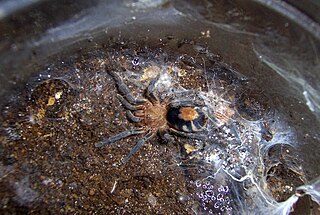
Hua Hin is one of eight districts (amphoe) of Prachuap Khiri Khan province in the northern part of the Malay Peninsula in Thailand. Its seat of government, also named Hua Hin, is a beach resort town. The district's population was estimated at 65,983 in December 2019 by the Bureau of Registration Administration in an area of 911 km2 (352 sq mi). By road, it is 199 km (124 mi) south-southwest of Bangkok.

The Thai Ridgeback is a dog from Thailand. The Thai Ridgeback is one of only three breeds that has a ridge of hair that runs along its back in the opposite direction to the rest of the coat. The other two are the Rhodesian Ridgeback and the Phu Quoc Ridgeback.

Golf arrived in Thailand during the reign of King Rama V at the Royal Bangkok Sports Club and Royal Hua Hin Golf Course. It was first played by nobles and other elites of high society but is now played by a wider segment of the population. Retail and fashion industries golf promotions are popular in the Si Lom Road part of Bangkok in Thaniya Plaza shopping mall.

Tarantulas comprise a group of large and often hairy spiders of the family Theraphosidae. As of December 2023, 1,100 species have been identified, with 166 genera. The term "tarantula" is usually used to describe members of the family Theraphosidae, although many other members of the same infraorder (Mygalomorphae) are commonly referred to as "tarantulas" or "false tarantulas". Some of the more common species have become popular in the exotic pet trade. Many New World species kept as pets have setae known as urticating hairs that can cause irritation to the skin, and in extreme cases, cause damage to the eyes.

Chilobrachys is a genus of Asian tarantulas that was first described by Ferdinand Anton Franz Karsch in 1892. They are found in India, Myanmar, Malaysia, China, Vietnam, Thailand and Sri Lanka. They are usually medium or large-sized, and they can stridulate by using small spines present on the chelicerae.

Phlogiellus is a genus of tarantulas that was first described by Reginald Innes Pocock in 1897. They are found throughout Asia and Papua New Guinea, including Indonesia, the Philippines, Papua New Guinea, China, Myanmar, Malaysia, Borneo, Thailand, the Solomon Islands and Taiwan. Phlogiellus is part Latin and part Greek, the first part being "φλóξ φλoγóϛ", meaning flame, the second part being "ellus" which is a latin diminutive suffix.

Encyocratella is a monotypic genus of Tanzanian tarantulas containing the single species, Encyocratella olivacea, also known as the Tanzanian black and olive baboon spider. It was first described by Embrik Strand in 1907, and is found in Tanzania.

Caribena laeta, otherwise known as the Puerto Rican pink toe tarantula, is a species of spider in the family Theraphosidae, found in the US Virgin Islands, Puerto Rico, and Cuba, the last dubiously according to Caroline Fukushima and Rogério Bertani in 2017. It was first described by Carl Ludwig Koch in 1842 under the name Mygale laeta.

Chilobrachys dyscolus is a species of spider in the tarantula family (Theraphosidae) native to Vietnam. It was first described by Eugène Simon in 1886 as Phrictus dyscolus. It is known as the blue Vietnam tarantula, Asian blue smokey tarantula, Asian smokey earth tiger tarantula or Burma chocolate brown tarantula.

Phu Laen Kha National Park is a national park in Thailand with a total area of 125,312.50 rai covering Amphoe Kaset Sombun, Amphoe Nong Bua Daeng, Amphoe Mueang Chaiyaphum and Amphoe Ban Khwao of Chaiyaphum Province in northeastern region.

Chilobrachys fimbriatus, commonly known as the Indian Violet Earth Tiger Tarantula usually shortened to Indian Violet Tarantula, is a species of spider of the genus Chilobrachys. It is endemic to India, and was first described by Reginald Innes Pocock in 1899.

Ceratogyrus marshalli, also known as Straight Horned Baboon or Great Horned Baboon Tarantula, is a species of tarantula from the genus Ceratogyrus. It is found in Zimbabwe and Mozambique. It was first described by Reginald Innes Pocock in 1897, as half of the Ceratogyrus genus, they own a impressive horn in the carapace.
Ornithoctonus aureotibialis is a tarantula species in the Ornithoctonus genus, it was first described by Volker von Wirth and Boris F. Striffler in 2005. It is named for the Latin, aureus being "golden" and tibia. Because of the gold or orange coloured line of hair in the tibiae of the legs in subadult and adult females and subadult males. Its common name is Thailand Golden Fringe, as the name may suggest it is found in Thailand, Myanmar and Malaysia. It is sometimes kept as a pet, and are captive bred.
Acanthoscurria insubtilis also known as the Bolivian black velvet tarantula, is a spider which was first described by Eugène Simon in 1892. It is found in Bolivia, with some reports also stating in Brazil, though it is mainly in the Bolivian Rainforests.
Eucratoscelus pachypus also known as the Tanzania stout leg baboon tarantula or the stout leg tarantula, was first described by Gunter Schmidt and Volker von Wirth in 1990. It is found in Tanzania, hailing from arid parts, and is an obligate burrower.

Harpactira cafreriana otherwise known as the Cape copper baboon or amber baboontarantula spider was first described by Charles Athanase Walckenaer in 1837. It is found in South Africa, being terrestrial or semi-fossorial in nature.
Cyriocosmus leetzi also known as the Columbian dwarf tiger or Venezuelan dwarf beauty tarantula is a tarantula which was first described by Fabian Vol in 1999. As its common names may suggest it is found in Colombia, with some people stating it is also found in Venezuela.

Cyriocosmus perezmilesi otherwise known as the Bolivian dwarf beauty tarantula is a spider which was first described by Radan Kaderka in 2007. It was named in honor of Dr. Fernando Pérez-Miles, and is a fossorial tarantula. As its common name aptly states it is found in Bolivia.
Heterothele gabonensis, also known as the Gabon blue dwarf baboon tarantula, is a species of tarantula found in Gabon. It was first described by Pierre Hippolyte Lucas in 1858, under the name Mygale gabonensis. They are semi arboreal tarantulas, that web quite a lot. They have also showed some communal tendencies in the form of tolerance for one another over an extended period of time.
Pamphobeteus vespertinus also known as the Ecuadorian red bloom tarantula is a tarantula first described in 1889 in Eugène Simon. They are found in the arid areas of Ecuador, and they are terrestrial tarantulas.













